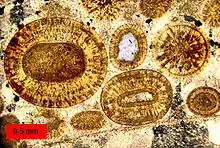Cementation (geology)
Cementation involves ions carried in groundwater chemically precipitating to form new crystalline material between sedimentary grains. The new pore-filling minerals forms "bridges" between original sediment grains, thereby binding them together. In this way sand becomes "sandstone", and gravel becomes "conglomerate" or "breccia". Cementation occurs as part of the diagenesis or lithification of sediments. Cementation occurs primarily below the water table regardless of sedimentary grain sizes present. Large volumes of pore water must pass through sediment pores for new mineral cements to crystallize and so millions of years are generally required to complete the cementation process. Common mineral cements include calcite, quartz or silica phases like cristobalite, iron oxides, and clay minerals, but other mineral cements also occur.

Cementation is continuous in the groundwater zone, so much so that the term "zone of cementation" is sometimes used interchangeably. Cementation occurs in fissures or other openings of existing rocks and is a dynamic process more or less in equilibrium with a dissolution or dissolving process.
Cement found on the sea floor is commonly aragonite and can take different textural forms. These textural forms include pendant cement, meniscus cement, isopachous cement, needle cement, botryoidal cement, blocky cement, syntaxial rim cement, and coarse mosaic cement. The environment in which each of the cements is found depends on the pore space available. Cements that are found in phreatic zones include: isopachous, blocky, and syntaxial rim cements. As for calcite cementation, which occurs in meteoric realms (freshwater sources), the cement is produced by the dissolution of less stable aragonite and high-Mg calcite. (Boggs, 2011)
Classifying rocks while using the Folk classification depends on the matrix, which is either sparry (prominently composed of cement) or micritic (prominently composed of mud).
Types of carbonate cement
Beachrock is a type of carbonate beach sand that has been cemented together by a process called synsedimentary cementation. Beachrock may contain meniscus cements or pendant cements. As the water between the narrow spaces of grains drains from the beachrock, a small portion of it is held back by capillary forces, where meniscus cement will form. Pendant cements form on the bottom of grains where water droplets are held.
Hardgrounds are hard crusts of carbonate material that form on the bottom of the ocean floor, below the lowest tide level. Isopachous (which means equal thickness) cement forms in subaqueous conditions where the grains are completely surrounded by water (Boggs, 2006).
Carbonate cements can also be formed by biological organisms such as Sporosarcina pasteurii, which binds sand together given organic compounds and a calcium source (Chou et al., 2010).
References
- Boggs, Sam Jr., 2006, Principles of Sedimentology and Stratigraphy, 4th ed., New Jersey, Pearson Education Inc.
- Boggs, Sam, Jr., 2011, "Principles of Sedimentology and Stratigraphy", 5th ed., New Jersey, Pearson Education Inc.
- Chiung-Wen Chou, Eric Seagren, Ahmet Aydilek, Timothy Maugel. "Bacterially-Induced Calcite Precipitation via Ureolysis", American Society for Microbiology 11 November 2008 Retrieved 20 February 2010.